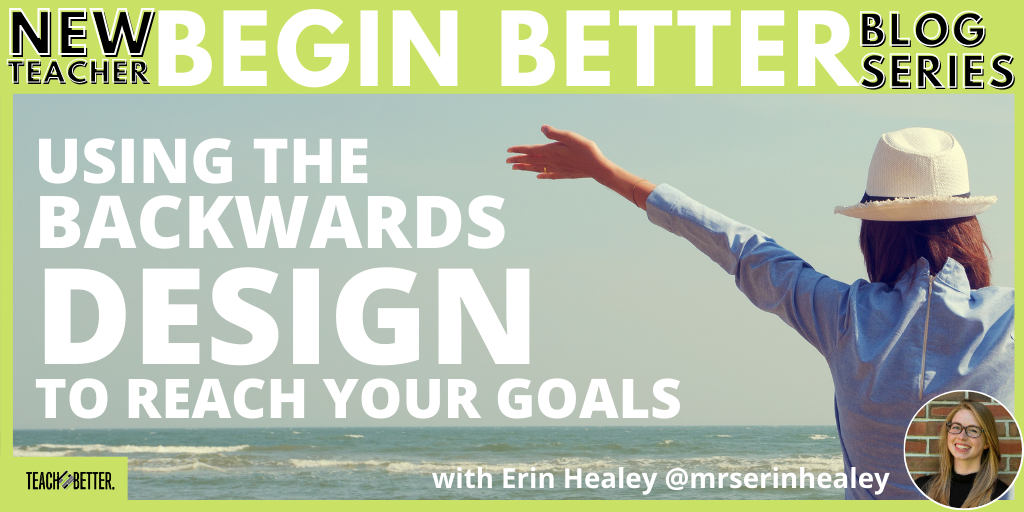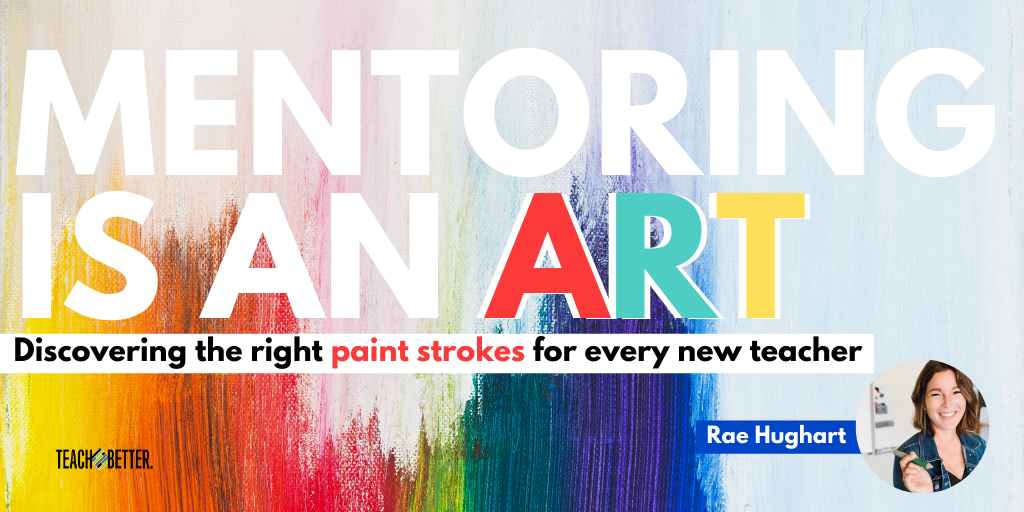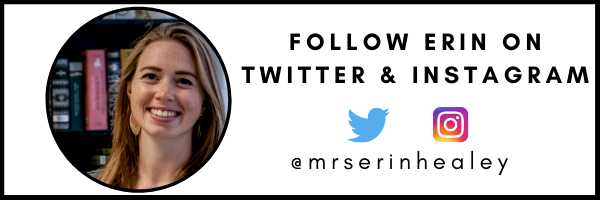TL;DR:
- Use the backwards design in your life to move toward your goals in a clear way.
- Plan your journey by creating a list of manageable steps to get to your goal. Write out your list, create a timeline, and give each task a reasonable deadline.
- A goal-setting template PDF download is shared.
Welcome back to our ‘Begin Better’ series for new teachers! Last time, I shared some quick tricks to help free up your time to focus on teaching better. Today I want to talk about planning and the backwards design—not just lesson planning for tomorrow, but creating a plan for your course, career, and life.
As a new teacher, it is incredibly daunting to leave college and be immediately faced with your future. Education as a career field is (normally!) very consistent, and you may be lucky enough to have landed the job that you will have for the rest of your professional life.
Or, you could be working as a TA, substitute, or part-time teacher, figuring out exactly what you want that job to be. It is a lot to take in as someone likely in your 20s! I absolutely believe in the power of goal-setting, and have found that visualizing my end goal has made me a lot more efficient with my time and energy right from the beginning. So without further ado, let’s dive into the concept of backwards design.
The better you can visualize your future goals and witness them in action, the more likely you are to put in the time and hard work necessary to achieve them. Click To TweetWhat is Backwards Design?
You probably remember this term from your curriculum classes. It is a highly effective form of unit planning; create the final assessment first, then design the rest of the unit to ensure students are building the skills necessary to succeed on that final project, test, or essay. When you know what the end result will be, it is easier to build manageable goals and scaffold resources for students. Starting the unit with a hard end date also helps to map out the timeline for your instruction!
Now, how can you apply this concept to every aspect of your life? Let’s start with your class.
Design Your Class Backwards
When I consider what skills my students need to succeed, I use Bloom’s Taxonomy to facilitate classroom activities that build skills, rather than just dictate content at my students. Using this framework, I look at my 80-minute class block as a time for students to recall past skills or content, learn new information, and put it immediately into practice.
My end goal for each class is for my students to be able to utilize the skills both in and outside of my class, and that is how I know they will be successful in our final assessment.
How does this look in a typical class?
Well, this year, I teach 10th grade English. My entry activity is a Google Form that I use to take attendance, which asks some sort of fun and engaging question that I can refer back to at some point in the class.
For example, I can ask for my students’ favorite movie or TV shows in the attendance form, then use one or two of those answers as examples in class to explain character development. Then, I dive into recall.
While teaching about poetic concepts such as metaphors, similes, allusions, etc., I ask them to remember everything they’ve learned about those topics and connect their past knowledge to an example that they have seen or read.
Once we’ve established a prior connection to the content, my students feel more confident to tackle the new information we are about to practice. We learn and practice, and re-learn and re-practice, and end the class with some expression of mastery from each individual student that I had planned prior to our class activities.
I already know that students should be successful, because we only practiced the skills and knowledge necessary to succeed on the formative assessment, and each formative assessment will be revisited in some way leading up to the end of the unit. This process helps you find efficiency in your lesson planning, and sets your students up for success!
Design Your Life Backwards

You may know you want to stay teaching 4th grade forever, or you ultimately want to transition to an administrative or leadership role.
It’s critical to change up your routine and push yourself outside your comfort zone for your long-term mental health, and you will need to write these goals down every few years for your evaluation cycle!
Seriously consider the person you want to be in 10-15 years.
Spend some time writing down everything you can about that person. What do they look like? What are they feeling and what do they know?
See if you can find someone—in your life or in your community—that is living your future best life. If they aren’t in your direct circle, connect with them on social media and learn more about their professional journey. Reach out to them for a phone meeting or cup of coffee! If they are in your direct circle, ask them to be your informal mentor.
The better you can visualize your future goals and witness them in action, the more likely you are to put in the time and hard work necessary to achieve them.
Conversely, the earlier you begin to witness your future goals in action, the more time you have available to you to alter course if you don’t actually like it! I thought that I would teach for a few years, then get a degree in administration and become a principal.
I reached out to a few administrators that I knew and really respected to get an informal cup of coffee, chat about their journey, and see if why they became a principal matched my goals. Yes, cold calling or emailing is scary, but I was so glad I did; I discovered that my intentions more closely aligned with teacher preparation than teacher leadership, and I was able to follow my true passion (even though that has led me away from the principal’s office).
Set Intentional (and Achievable) Benchmarks
Now that you have the end in sight, what are the steps you need to take to achieve that goal? Write down as many obstacles as you can imagine that stand between you and the finish line.
When your list is done, set your timer for 30 minutes and do some research. Don’t go down a rabbit hole! There are any number of awesome professional development workshops, conferences, or graduate programs out there in your area of interest, and it can be overwhelming. Odds are, learning more about your goal is probably one of the steps you will need to take!
[scroll down to keep reading]Each of these challenge points is going to become a stepping stone in your journey.
Organize these in a chronological manner. Then, under each of those points, assign yourself manageable tasks that you can literally check off as you slowly start to conquer these challenges. Following up with your new mentor, either with another conversation or a nice thank you note, should probably go at the top of your list!

I love going old-school and literally checking off boxes, and recommend that once you’ve drawn out this list, write it down! Grab a piece of paper and your favorite Flair pen, and make a nice copy of your to-do lists. Thinking over your process a second time, as you write it down, ensures that the journey you are creating is intentional and achievable.
Finally, create a timeframe that you can stick to. This could be your current academic year, evaluation cycle, or the next few weeks.
Give each of your smaller tasks a deadline that you can reasonably meet, while keeping in mind all of the other responsibilities in your life. Sometimes, you may have a hard end date (evaluations, or application deadlines, for example).
In other situations, you may find that you need more (or less!) time than you had initially envisioned in order to be truly successful. That is ok! You are taking a dream you have and making it your life!
I’m sure you can visualize this process in the classroom, but when it comes to tackling your biggest career goals, what does this look like?
Print out my free goal-setting template and start dreaming today! I can’t wait to support you on this journey. Please share your success stories or questions, and connect with me on social media! Next time, we’ll look at how to up your communication game with students, parents, and community members, as we head into the end of the semester.
About Erin Hall
Erin Hall is an English Teacher at Chariho Regional High School and the Founder & CEO of the Young Educators Society of Rhode Island. YESRI is an organization where educational professionals with less than 10 years of experience can connect, collaborate, and learn from each other.




